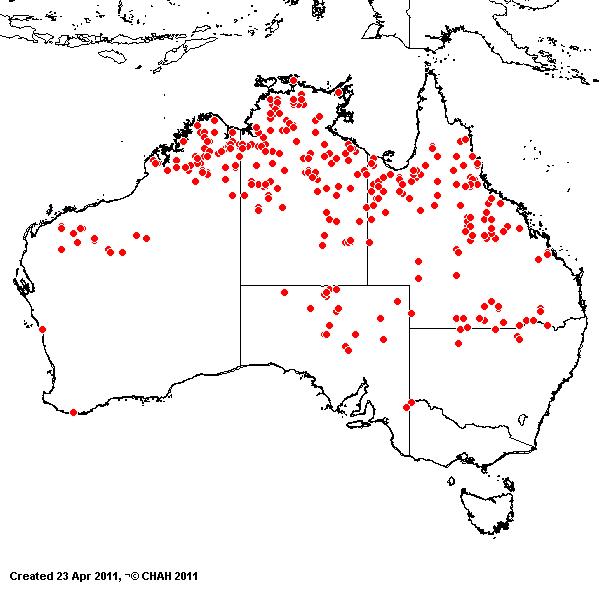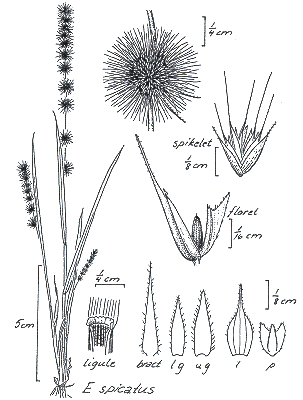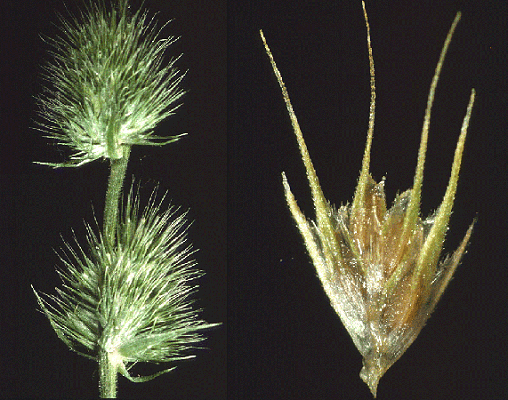Elytrophorus spicatus (Willd.) A. Camus. Fl.
Gen. Indo-Chine 7: 547 (1923).
Classification. (GPWG 2001) : Subfamily Danthonioideae. Tribe
Danthonieae.
Basionym and/or
Replacement Name: Dactylis
spicatus Willd., Ges. Naturf. Freunde Berlin Neue Schriften 3: 416
(1801).
Type of Basionym or
Protologue Information: India:, Klein s.n. (HT: B-W; IT: K).
Key references
(books and floras): [1878] G.Bentham, Flora Australiensis 7 (638 as Elytrophorus
articulatus), [1952] C.A.Gardner, Flora of Western Australia 1 Gramineae
(86), [1981] M.Lazarides in J.Jessop (ed)., Flora of Central Australia
(444), [2002] D.Sharp & B.K.Simon, AusGrass, Grasses of Australia,
[2006] J.Jessop, G.R.M.Dashorst, F.M.James, Grasses of South Australia
(301), [2008] S.W.L.Jacobs, R.D.B.Walley & D.J.B.Wheeler, Grasses of New
South Wales (239).
Illustrations:
[1952] C.A.Gardner, Flora of Western Australia 1 Gramineae (87,
Pl. 24), [2005] K.Mallet (ed.), Flora of Australia 44B: Poaceae 3
(Fig.3, F-G), [2006] J.Jessop, G.R.M.Dashorst, F.M.James, Grasses of South
Australia (300, Fig. 236), [2008]
S.W.L.Jacobs, R.D.B.Whalley & D.J.B.Wheeler, Grasses of New South Wales,
4th edn (239).
Habit. Annual.
Culms erect, 5–60 cm tall. Ligule an eciliate membrane. Leaf-blades 5–25 cm
long, 2–6 mm wide.
Inflorescence.
Inflorescence compound, a panicle. Panicle linear, 2–30 cm long, (0.3–)0.5–0.7
cm wide.
Spikelets.
Spikelets sessile, 3–5 in the cluster. Companion spikelets sessile, 3–5 in the
cluster. Involucre composed of imperfect spikelets. Companion spikelets
represented by single glumes, 1–2 mm long. Companion spikelet glumes awned.
Fertile spikelets many flowered, with at least 2 fertile florets (3–7),
comprising 3–7 fertile floret(s), with diminished florets at the apex, ovate,
laterally compressed, 2–5 mm long.
Glumes. Glumes
similar, similar to fertile lemma in texture. Lower glume lanceolate,
membranous, without keels, 1 -nerved. Lower glume apex awned. Upper glume
lanceolate, 1–1.5 mm long, membranous, keeled, 1-keeled, 1 -nerved. Upper glume
apex awned.
Florets.
Fertile lemma 1–1.5 mm long, keeled, 3 -nerved. Lemma surface indumented. Lemma
apex awned, 1 -awned. Median (principal) awn 1–2.2 mm long overall. Palea 2
-nerved. Palea keels with toothed wings. Lodicules present. Anthers 1–3. Grain
0.5–0.9 mm long.
Continental
Distribution: Africa, Temperate Asia, Tropical Asia, and Australasia.
Australian
Distribution: Western Australia, Northern Territory, South Australia,
Queensland, New South Wales.
Western Australia:
Gardner, Fitzgerald, Dampier. Canning, Fortescue, Carnarvon. Northern
Territory: Darwin & Gulf, Victoria River, Barkly Tableland, Central
Australia North. South Australia: North-western, Lake Eyre, Murray. Queensland:
Burke, Cook, Darling Downs, Gregory North, Maranoa, North Kennedy, Port Curtis,
South Kennedy, Warrego, Mitchell.
Notes.
A group of collections (e.g. Perry 2356, Latz 2248, 1675, Swinbourne
732) from the Northern Territory, near Alice Springs, differs from the
typical form by shorter awns, almost undeveloped awns, and much wider palea
wings. Distinct from E. globularis by the smaller anthers, much smaller
sterile subtending bracts, and by the spikelet glomerules more frequently
confluent. However, they may be forms of the same species.
.
Widespread
in the semi-arid parts of southern Africa through Asia to Australia, damp soil
along creeks, and damp hollows and seepages in tropical areas, sometimes common
locally, forming extensive mats of bright-green plants, although Lazarides
(1970) notes that it may be rare. Flowers April, May, June, and July.






